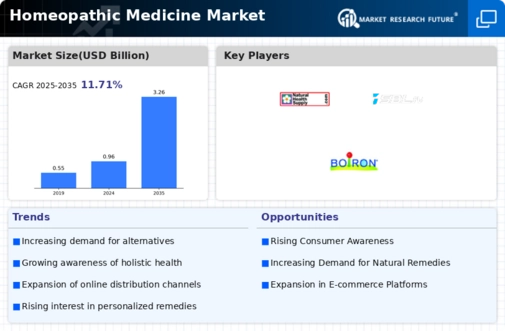Growing consumer demand for natural and holistic healthcare is driving the market growth.
The rising demand for natural and holistic healthcare drives market CAGR for homeopathic medicine. With rising health consciousness and concerns regarding the side effects of conventional drugs, consumers are seeking alternative therapies that offer a more natural approach to healing. Homeopathy, focusing on individualized treatments and minimal side effects, has gained popularity among a significant portion of the population. The spreading prevalence of chronic diseases such as cardiovascular disorders, respiratory illnesses, and autoimmune conditions also drives the shift toward natural remedies.
Homeopathic medicines, known for their potential to treat chronic ailments effectively, have become an attractive choice for patients seeking long-term relief. The COVID-19 pandemic has also taken the importance of maintaining a strong immune system, leading to a surge in demand for homeopathic immune-boosting products.
The regulatory landscape and quality assurance practices influence the homeopathic medicine market. In recent years, regulatory bodies in various countries have taken steps to establish standards and guidelines for homeopathic products. These measures aim to ensure homeopathic medicines' safety, efficacy, and quality, instilling confidence among consumers and healthcare professionals. Regulatory authorities have been focusing on implementing stringent regulations for product registration, labeling, and manufacturing practices. The enforcement of these regulations has resulted in improved product quality and standardization within the industry. Manufacturers are increasingly investing in research and development to meet regulatory requirements and enhance the credibility of their products.
These organizations play a crucial role in independently verifying the quality and authenticity of homeopathic medicines, assuring consumers of their safety and effectiveness. Such quality assurance measures are essential for building trust in the market and maintaining the reputation of homeopathic medicine as a viable healthcare option.
Technology has played an important role in facilitating the accessibility and distribution of homeopathic medicines. Online platforms and e-commerce websites have emerged as convenient channels for consumers to purchase homeopathic remedies, expanding the reach of manufacturers and suppliers. Furthermore, advancements in telemedicine and mobile applications have enabled the provision of remote consultations and personalized treatment recommendations. Patients can now consult homeopathic practitioners from the comfort of their homes, eliminating geographical barriers and enhancing convenience. This integration of technology not only improves patient access to homeopathic care and enhances the overall patient experience.
Homeopathic medicine manufacturers and practitioners are utilizing these platforms to disseminate information, share success stories, and promote the benefits of homeopathic treatments. The digital landscape has significantly contributed to the growth and visibility of the homeopathic medicine market.
The homeopathic medicine market is witnessing significant growth, driven by the increasing consumer demand for natural and holistic healthcare, technological advancements, and regulatory frameworks to ensure product quality. As the popularity of homeopathy continues to rise, manufacturers, practitioners, and regulatory bodies must collaborate to meet consumer expectations, enhance accessibility, and maintain high standards of quality, driving the Homeopathic Medicine market revenue.
The increasing consumer inclination towards natural and holistic treatment options appears to be driving a notable expansion in the global homeopathic medicine market.
World Health Organization (WHO)














